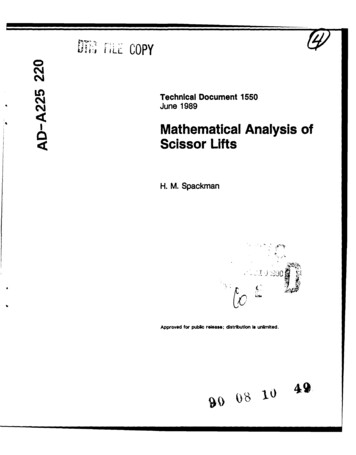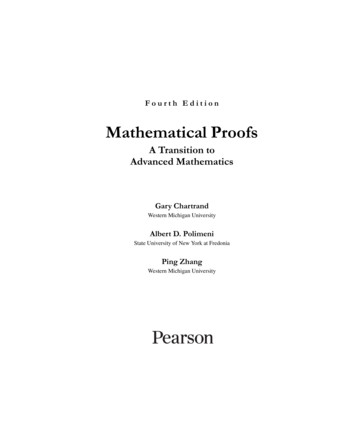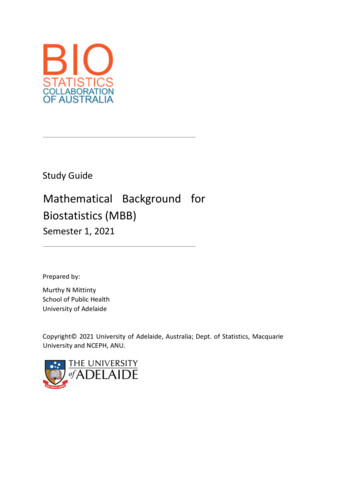
Transcription
Study GuideMathematical Background forBiostatistics (MBB)Semester 1, 2021Prepared by:Murthy N MittintySchool of Public HealthUniversity of AdelaideCopyright 2021 University of Adelaide, Australia; Dept. of Statistics, MacquarieUniversity and NCEPH, ANU.
ContentsAcademic Coordinators . . . . . . . . . . . . . . . . . . . . . . .3Other Contacts . . . . . . . . . . . . . . . . . . . . . . . . . . . .4Welcome Letter. . . . . . . . . . . . . . . . . . . . . . . . . . .5Unit Background . . . . . . . . . . . . . . . . . . . . . . . . . . .6Unit Objectives . . . . . . . . . . . . . . . . . . . . . . . . . . . .7Unit Content. . . . . . . . . . . . . . . . . . . . . . . . . . . . .8Software. . . . . . . . . . . . . . . . . . . . . . . . . . . . .8Learning Resources. . . . . . . . . . . . . . . . . . . . . .9Workload requirements. . . . . . . . . . . . . . . . . . . . . .10Method of Delivery. . . . . . . . . . . . . . . . . . . . . . . . .10Staff Roles . . . . . . . . . . . . . . . . . . . . . . . . . . . .10Method of communication with coordinator(s). . . .11Assessment. . . . . . . . . . . . . . . . . . . . . . . . . . . . . . .12Unit Timetable . . . . . . . . . . . . . . . . . . . . . . . . . .13Late Submission of Assessments and Extension Procedure . . . . . . . . . . . . .14Submission of assessments and academic honesty policy . . . . . . . . . . . . . . . .14eLearning . . . . . . . . . . . . . . . . . . . . . . . . . . . . . . . .15eLearning Helpdesk. . . . . . . . . . . . . . . . . . . . . .15Week by Week Key Points . . . . . . . . . . . . . . . . . . . . .16Assignment Submission. . . . . . . . . . . . . . . . . . . . . . .21BCA Assessment Guide - MBB . . . . . . . . . . . . . . . .22Feedback. . . . . . . . . . . . . . . . . . . . . . . . . . . . . . . .22Acknowledgements. . . . . . . . . . . . . . . . . . . . . . . . . . . . . . . .22
Academic CoordinatorsMurthy N MittintySenior Lecturer in BiostatisticsSchool of Public HealthThe University of Adelaide,Adelaide SA 5005Phone: (08) 8313 0967Email: murthy.mittinty@adelaide.edu.auTutorMeghana KulkarniEmail: meghana.kulkarni@adelaide.edu.au
Other ContactsIf you have trouble contacting the academic coordinator/academic staff, or haveany other queries, please contact:Executive OfficerBiostatistics Collaboration of AustraliaNH&MRC Clinical Trials CentreUniversity of SydneyNSW 2006Phone: (02) 9562 5076 Fax:(02) 9562 5350Email: bca@ctc.usyd.edu.au
Welcome LetterDear Student,Welcome to Mathematical Background for Biostatistics (MBB). In this unit, we willdevelop the basic mathematical background needed to understand the proofs andmathematical reasoning used in the detailed treatment of biostatistical methods insubsequent units. Completion of this unit will allow you to concentrate on thestatistical concepts presented in the later units without being distracted by thedetail of the mathematical techniques.In light of the preparatory nature of the material, the primary sources are twomathematics textbooks. There is little requirement for reading beyond these works.One topic worthy of mention is the role of computer algebra systems (CAS) inrelation to this unit. These are computer programs capable of solving abstractmathematical problems and are accessible on a number of platforms including CAScalculators, specialised packages such as Maple and Mathematica and on websitessuch as http://www.wolframalpha.com. Such packages are able to solve many of theproblems given in the textbook with little e ort or understanding on the part of theuser. It is therefore important to understand that the purpose of setting exercisesis to help you develop skills in mathematical reasoning through practising thecalculations rather than just to get a correct answer by any means available. It is, ofcourse, convenient and useful to use a CAS package to check your calculations butyou should not allow this to become the focus.Please don’t hesitate to contact us if you are having problems with the unitmaterial.Murthy N Mittinty & Meghana KulkarniMarch 2021
Unit BackgroundThis unit of study is offered throughout Australia through the BiostatisticsCollaboration of Australia (BCA). It is available in distance learning mode only, tostudents enrolled in postgraduate degrees in biostatistics coordinated by the BCA.The purpose of MBB is to prepare students with little training in mathematics tostudy statistics at an advanced level. Students who have studied mathematics orstatistics at undergraduate level, or who have equivalent work experience, areexempted from this unit.On completion of this unit you should be able to follow the mathematicaldemonstrations and proofs used in biostatistics at Masters degree level, and tounderstand the mathematics behind the statistical methods introduced. This willallow you to concentrate on statistical concepts in subsequent units of your BCAprogram, with confidence in your mathematics.The use of eLearning (sometimes referred to as Canvas) is very important in thisunit and provides a guide to the unit material. This is the forum used to generatediscussion of the unit content, to answer questions and to ensure that studentshave a solid comprehension of the necessary concepts.
Unit ObjectivesOn completion of this unit, students should be able to:(1) Manipulate general mathematical expressions and inequalities.(2) Understand the notion of a limit and calculate simple limits.(3) Understand the notion of the derivative and its applications, and calculatesimple derivatives.(4) Understand the notion of the integral and its applications, and calculatesimple integrals.(5) Manipulate and evaluate simple matrix expressions.(6) Understand matrix concepts such as determinant, inverse, rank, orthogonalmatrix, eigenvalues and eigenvectors.(7) Appreciate the nature and importance of mathematical arguments.
Unit ContentThe subject will consist of three modules. These will cover the topics of:Module 1Numbers, Functions and LimitsModule 2CalculusModule 3MatricesModule 1 will require approximately 2 weeks of study, Module 2 will requireapproximately 4 weeks of study and Module 3 will require approximately 5 weeksof study, with a week free after each module for the associated assignment. Thework for each week consists of readings and exercises. The exercises are notassessed, but the assignment questions will be similar so the exercises will be usefulpractice. Material will be accessed through the textbooks, which are requiredreading. Additional material will be provided as required. Notes for each modulewill be provided on eLearning and will include the relevant text references, notesand exercises. Written material will be supplemented by discussion on eLearning.SoftwareThe computing in this unit does not require a statistical software package. However,graphs are an important tool for understanding mathematics, and we assume youhave access to either Wolfram Alpha, Microsoft Excel, R or Stata and can use it forcalculations and for graphing functions. The student resources page on the BCA website provides self-teaching materials for Excel, R and Stata.Wolfram Alpha is free and can be accessed at http://www.wolframalpha.com. R can befreely downloaded from CRan. If you require us to provide R code for any of theexercises please do not hesitate to send us an email.
Learning ResourcesYou WILL NEED a copy of both of the following textbooks, making sure you have theexact edition mentioned:Anton H, Bivens I and Davis SCalculus Early Transcendentals, 11th Edition (Wiley, 2015) ISBN9781118883822It is available via Wiley Direct: ranscendentals-11thedition/It is also available from university bookshops or online fromamazon.com.fishpond.com.auorBe sure you have the correct version: not single variable, not latetranscendentals and not brief edition. The ISBN identifies the right one.Anton HElementary Linear Algebra, 12th Edition ISBN 978-1-119-28236-5(Hardcover); eText: 978-1-119-40672-3orElementary Linear Algebra: Applications Version, 12th Australia and New ZealandEdition Howard Anton, Chris Rorres, Anton KaulISBNs E-Text: 9781119670858, Hard Cover Textbook: 9781119666066Note that the two versions listed above are exactly the same for the purposesof this course. The exercises set, the required readings and the page numbershave all been checked to be identical between the two versions.It is available via Wiley Direct: https://www.wiley.com/enus/Elementary Linear Algebra%3A Applications Version%2C 12th Edition-p-9781119406723It is also available from university bookshops or online fromamazon.com.fishpond.com.auPlease note: WileyPLUS is not an accessible resource (or required) for students inthis course. There is no need to purchase these textbooks with WileyPLUS should itbe offered.Workload requirementsThe expected workload for this unit is 10-12 hours per week on average, consistingof exercises, discussions posts, independent study and completion of assessmenttasks.or
Method of DeliveryStudents will be provided with three modules, as outlined in the previous section.These modules will also be made available on eLearning. The unit assessments willbe available on eLearning and will not be provided to students on an individualbasis. Important announcements will also be placed on eLearning, so studentsshould regularly monitor eLearning.Communication should generally be via eLearning (unless of a personal/confidential nature) as responses to questions and discussion of issues is of benefitto all students. eLearning is an integral component of the MBB unit as it hopefullyreduces the isolation which can occur in distance learning. Students can postquestions, ideas, suggestions and discussion on eLearning. The tutors will monitorand respond to all communication, however students are also encouraged torespond and take part in these communications.Staff RolesThe academic co-ordinator (Murthy N Mittinty) will be responsible for the unit andwill contribute to the discussion on eLearning and respond to content-relatedquestions.
Method of communication with coordinator(s)You can contact Murthy N Mittinty directly in relation to requests related topersonal matters. Email is the preferred method of contact for this kind of requests,with email addresses is stated earlier in this Study Guide.To facilitate timely responses to your enquiries, please include BCA MBB and themodule in question, or general enquiry, in the subject field of all emails. Forexample, include one of the following in the subject line of your email:Assignment number deadlineAssignment number submissionAssignment number content questionModule number questionTextbook questionAdministrative questionWe would like to note, that we strongly encourage questions regarding coursecontent to be posted on eLearning to generate and facilitate discussion.For more general enquiries regarding the BCA program, or if you are having troublecontacting the academic coordinators/staff please contact Executive Officer.
AssessmentThe assessment for this unit will involve three written assignments.Assignment 1 will cover Module 1 and will be worth 20%.Assignment 2 will cover Module 2 and will be worth 40%.Assignment 3 will cover Module 3 and will be worth 40%.All assignments will be posted on eLearning two (module 1) or three (modules 2and 3) weeks prior to the submission date. Model solutions/guides will be postedon eLearning after the submission date.Individual feedback on assignments will be provided to each student. Students areexpected to monitor eLearning for the posting of assignments, solutions andfeedback. Email notifications and other channels of communication will not beused. You may submit neatly handwritten work, however please note that markswill potentially be lost if the solution cannot be understood by the markers due tounclear or illegible writing. This handwritten work should be scanned and collatedinto a single pdf le and submitted via the eLearning site. See the BCA AssessmentGuide document for specific guidelines on acceptable standards for assessablework. Once you scan your document please check that the page turnover nicelyfollow the order and the scanning is not done in reverse order on odd and evenpages. The instructors will generally avoid answering questions relating directly tothe assessable material until after it has been submitted, but we encouragestudents to discuss the relevant parts of the notes among themselves, viaeLearning. However explicit solutions to assessable exercises should not be postedfor others to use, and each student’s submitted work must be clearly their own,with anything derived from other students’ discussion contributions clearlyattributed to the source.Examples and exercises are contained in each module to enable students toascertain their level of understanding of various topics. These will not form part ofthe assessment for this unit.The Unit Timetable below shows the due dates for the assignments and a guide tothe pace at which students should progress through the unit material.
Unit TimetableSemester 1, 2021 will commence on Monday 1st March.StudyWeekWeek Commencing11 March28 MarchTopicModule 1: Numbers andFunctionsModule 1: LimitsAssessmentAssignment 1Available15 March322 MarchModule 2: Calculus 1429 March55 AprilMid Semester Break 1week only612 AprilModule 2: Calculus 319 AprilModule 2: Calculus 426 AprilModule 3: Matrices andDeterminants78Module 2: Calculus 293 MayModule 3: Vector Spaces I1010 MayModule 3: Vector Spaces II1117 MayModule 3: Least Squares24 MayModule 3: Eigenvalues,Eigenvectors andDiagonalization12Assignment 1Due: Monday 5thApril31 MayAssignment 2Due: Monday 3 MayAssignment-3AvailableAssignment 3Due: Monday 31MayLate Submission of Assessments and Extension ProcedureThe standard BCA policy for late penalties for submitted work is a 5% deductionfrom the earned mark for each day the assessment is late, upto a maximum
demonstrations and proofs used in biostatistics at Masters degree level, and to understand the mathematics behind the statistical methods introduced. This will allow you to concentrate on statistical concepts in subsequent units of your BCA program, with confidence in your mathematics. The use of eLearning (sometimes referred to as Canvas) is very important in this unit and provides a guide to .

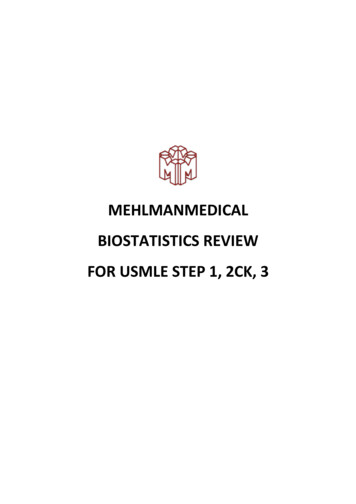
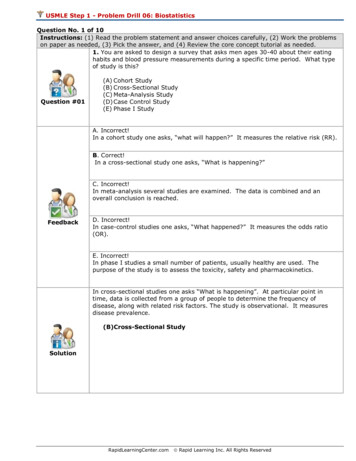
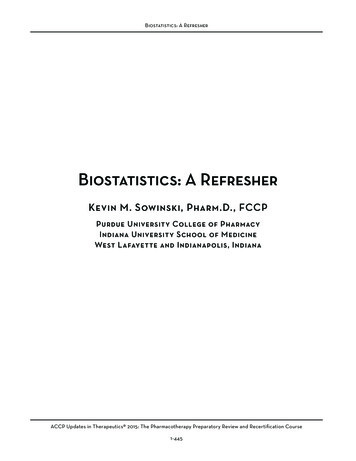
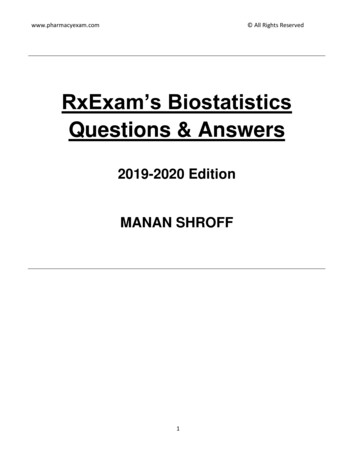
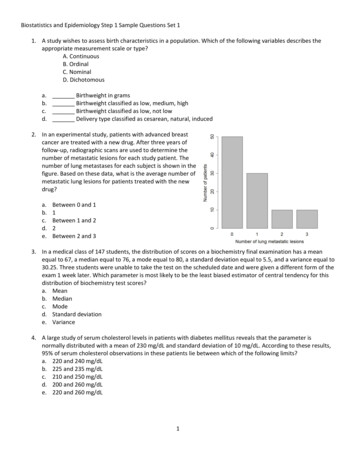
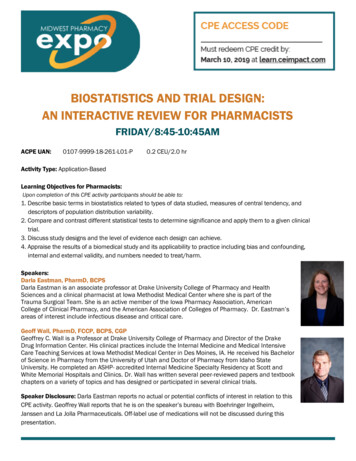
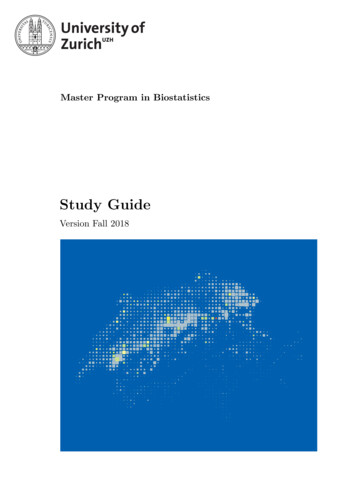
![Clinical Biostatistics [CLB]](/img/6/study-guide-clb-2021.jpg)
